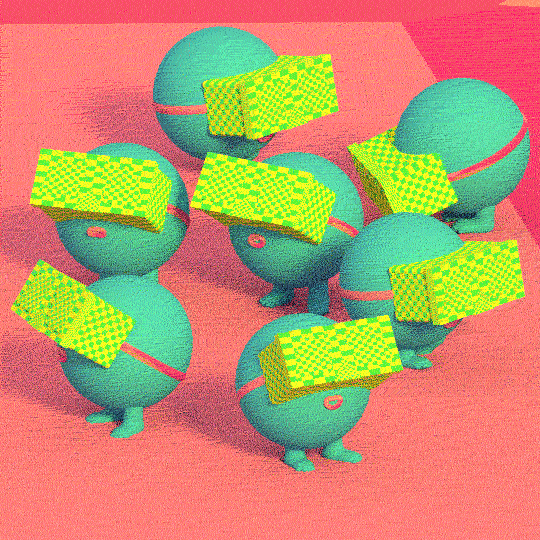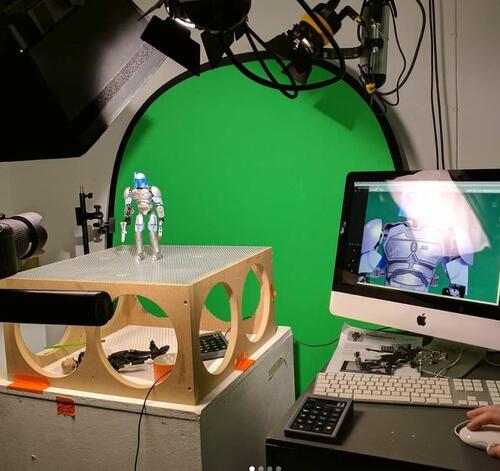It’s not much of stretch to say that if Picasso was kicking around as a thirteen-year-old in A Coruňa circa 2019, he might have ditched his paint-set and started coding a smartphone app that moves your nose to where your ears should be and turns the sky green.
Magritte might have made a Google VR headset that took you in to a world of perfect clouds and floating apples, and projection mapping might have madeChrist The Redeemer appear as if he was dabbing every 45 minutes for onlooking tourists.
Maybe The Shining would not have been a book or a film, but an interactive video gaming where you explore and experience the descent into paranoia and paranormal at The Overlook Hotel. You’d probably need a bourbon or two yourself after that.
Where tech is now, and where it’s headed, means artists can create entire realities from a Macbook Pro and audiences can experience great art in ways they never have before.
It’s liberating and likely revolutionary. Herefordshire artists Jaime Jackson and Jim Reid are already throwing themselves into it.

Hereford College of Arts is also getting ahead of it. Their new Digital Future and Interactive Media course will train the next generation of creators to use a whole range of tech to bring their ideas to life. And it looks really, really fun.
The two-year full-time course, launching in September 2019, will covers Green Screen, AR, VR, 360 audio, and video game design. The college say it will offer students pportunities to specialise, as well as to train alongside professionals currently working in digital storytelling.
We spoke to HCA's Shell Bufton about the possibilities it brings, from walking through Van Gogh's World and to bringing Queenswood's leaves to life.
What’s the most Out There concept for AR or VR that could be commonplace in 10 years’ time?
There are so many great applications that will likely (hopefully) be commonplace in 10 years.
From helping people overcome physical limitations like playing the piano or, as one of the students who came for an interview for the Digital Futures program was discussing, its use in medical training applications.
There are some cool projects being done at the intersections of the tools as well, like projected AR and motion capture. The Royal Shakespeare Company teamed up with Intel and the Imaginarium for a production of The Tempest using AR to create virtual avatars of actors on stage.
Which Herefordshire buildings or features would you love to see digital mapping projection on?
Hereford Cathedral, hands down.
We also really love local art collective Salt Road’s Biophilia projects. They’ve done some great projection projects with bridges in cities world-wide. It would be amazing to invite them to explore something similar with our Digital Futures students and the St. Martin’s Street Bridge.
HCA is unique to the area in that everything is project-based so students get hands-on industry experience working along industry experts.
National Trust property Berrington Hall, near Leominster, might be checked off our bucket list thanks to the Pleasure Garden exhibition’s opening night in March 2019, but we'd love to return once they have completed their Georgian garden restoration project.
Using digital restoration projections could bring history back to life - some of the Shire's castle ruins. And any of the region’s forests would be an amazing setting for a wonderland inspired by Friedrich van Schoor and Tarek Mawad’s work (see below).
It’s great to be located in an area with so many options.
Video game revenue already outstrip Hollywood ticket sales. If Tarantino was a teenager today, do you think he’d be more likely to use video game design to tell his stories, instead of film?
Tarantino has a colourful way of explaining his loathing of CGI and video games, but that might have a lot to do with what was available as a story telling medium as he was growing up. During his youth the extent of video games was Pong.
Before the 1970s computers that ran video games were super expensive and still outside the domain of consumer grade. The first consumer grade camcorders weren’t available until the 1980s. It has taken video games a lot longer to develop as a storytelling medium. Film as a medium was established almost a hundred years before and had theatre as a foundation it could loosely grab hold of.
The interactivity of video games took a while to figure out too, so maybe if Tarantino grew up in a world where video games were a viable storytelling medium, possibly he’d choose gaming.
But both mediums have their own strengths and limits. Our Digital Futures students will get to explore both (along with many more) and see what fits their creative voice best.
Instagram account (@hca_digitalfutures) captures digital projects already coming out of the art college. Can you tell us a bit more about them?
Some of my favourite shots on @hca_digitalfutures are from events we’ve done with partners, like the film careers panel we held with Rural Media at the Aesthetica Short Film Festival or the Hay Festival workshops we ran with Anorak magazine.
Project-wise, HCA students had the amazing opportunity to travel to Brussels earlier this year and create an installation-piece reflective around the theme of Herefordshire. It was a massive undertaking and a once-in-a-lifetime opportunity.
The original idea for that piece developed in our 3D printing workshop and it was great to see on how many levels digital and traditional creativity mix together.
This is one of the best parts of the course: students are encouraged to work among the other programs such as Art & Design, Music and Performing Arts to come up with interdisciplinary projects. They aren’t stuck in a box.

Do you think digital art and interactive media can bridge the gap between consuming content on screens and real-life experience?
What we are seeing is interactive media not bridging the consumption gap but redefining real-life as we know it for the better.
It has become the predominate means of communicating ideas and sharing knowledge, as opposed to just a channel for media consumption. I went to a conference in March at the Barclay’s FinTech Incubator at Rise London on The Future of Learning where we looked at how technologies like VR and artificial intelligence (AI) were changing the way people learned - not just making learning in the traditional memorize-test way easier but completely reshaping it.
Learning is becoming more microtransactional, more experiential, more project-based. You learn what you need when the project calls for it. What was really interesting for me was realising that here is this college in the West Midlands that has done away with the old-fashioned test-based system and where students are learning through projects instead. That's exactly what you need in an industry that changes as fast as digital media.
What does the term immersive technology mean?
At the moment the industry tends to limit this term to include only VR and AR but more and more often this is being redefined to include technologies that not only transport users to virtual experiences but those that integrate with real-time reality, like conversational agents and the Internet of Things.
Carrières de Lumières in France has an immersive retrospective of Van Gogh’s work allowing you to walk through his paintings. This is not VR or AR based, but could still be considered immersive.
The criteria that defines “immersive” is blurring as technologists push the boundaries of the tools, delivery channels expand and everything starts to integrate with one another. Facebook’s Codec Avatar and Google’s Duplex projects are prime examples.
If people are interested in Digital Futures, what ambitious projects from around the world right should they know about?
You don’t have to look much further than the West Midlands.
One of our favourite artists and technologists is HCA 2003 graduate James Gardner whose first full feature film Jellyfish has won a massive amount of awards and acclaim from critics. Then there's work coming from digital media professionals and artists from the Invisible Arts Network based in and around Herefordshire.
Find out more about the Digital Futures and Interactive Media course at Hereford College of Arts open days on April 9 and May 15. Details here. Alternatively, contact the college for an informal tour.
Read more: Atelier des Lumières, Paris.